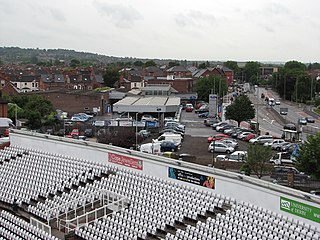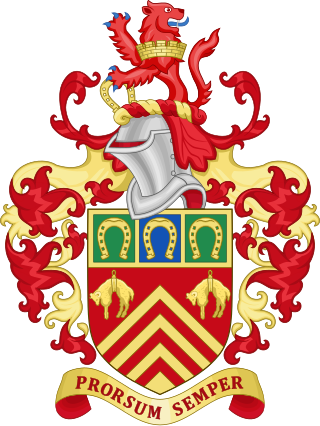
Broxtowe is a local government district with borough status in Nottinghamshire, England. It lies immediately west of the city of Nottingham, and most of the built-up areas of the borough form part of the Nottingham Urban Area. The council is based in Beeston and the borough also includes the towns of Eastwood, Kimberley and Stapleford and surrounding villages and rural areas.

Rushcliffe is a local government district with borough status in south Nottinghamshire, England. Its council is based in West Bridgford. The borough also includes the towns of Bingham and Cotgrave as well as numerous villages and surrounding rural areas. Some of the built-up areas in the north-west of the borough, including West Bridgford, form part of the Nottingham Urban Area.

Gedling is a local government district with borough status in Nottinghamshire, England. The council is based in Arnold. The borough also includes Carlton along with villages and rural areas to the north-east of Nottingham. The main built-up part of the borough around Arnold and Carlton forms part of the Nottingham Urban Area.

Mansfield District is a local government district in Nottinghamshire, England. It is named after the town of Mansfield, where the council is based. The district also contains Mansfield Woodhouse and Warsop.

Hertfordshire County Council is the upper-tier local authority for the non-metropolitan county of Hertfordshire, in England. The council was created in 1889. It is responsible for a wide range of public services in the county, including social care, transport, education, and the Hertfordshire Fire and Rescue Service. The Conservatives have held a majority of the seats on the council since 1999. The council is based at County Hall in Hertford.

Leicestershire County Council is the county council for the English non-metropolitan county of Leicestershire. It was originally formed in 1889 by the Local Government Act 1888. The county is divided into 53 electoral divisions, which return a total of 55 councillors. The council is controlled by the Conservative Party. The leader of the county council is currently Nick Rushton, who was elected to the post in September 2012. The headquarters of the council is County Hall beside the A50 at Glenfield, just outside the city of Leicester in Blaby district.

Nottingham City Council is the local authority for Nottingham, a unitary authority with city status. Nottingham is in the ceremonial county of Nottinghamshire, England, but as a unitary authority the city council is administratively independent from the surrounding Nottinghamshire County Council. The city council consists of 55 councillors, representing a total of 20 wards, elected every four years. The council is led by David Mellen, of the majority Labour Party.

Surrey County Council is the county council for the non-metropolitan county of Surrey, England. The council is composed of 81 elected councillors, and in all but one election since 1974 the Conservative Party has held the majority. The leader of the council is Tim Oliver.

Suffolk County Council is the administrative authority for the county of Suffolk, England. It is run by 75 elected county councillors representing 63 divisions. It is a member of the East of England Local Government Association.

Warwickshire County Council is the county council that governs the non-metropolitan county of Warwickshire in England. Its headquarters are at Shire Hall in the centre of Warwick, the county town. The council's principal functions are county roads and rights of way, social services, education and libraries, but it also provides numerous other local government services in its area.

Gloucestershire County Council is the upper-tier local authority for the non-metropolitan county of Gloucestershire, in England. The council was created in 1889. The council's principal functions are county roads and rights of way, social services, education and libraries, but it also provides many other local government services in the area it covers. The council's administrative area does not include South Gloucestershire, which is a unitary authority with all the functions of a county and a non-metropolitan district. The council is based at Shire Hall in Gloucester.

Worcestershire County Council is the county council for the non-metropolitan county of Worcestershire in England. Its headquarters are at County Hall in Worcester, the county town. The council consists of 57 councillors and is currently controlled by the Conservative Party.

Essex County Council is the county council that governs the non-metropolitan county of Essex in England. It has 75 councillors, elected from 70 divisions, and has been under Conservative majority control since 2001. The council meets at County Hall in the centre of Chelmsford. It is a member of the East of England Local Government Association.

Staffordshire County Council is the upper-tier local authority for the non-metropolitan county of Staffordshire, England. The non-metropolitan county differs from the ceremonial county, which additionally includes Stoke-on-Trent.

Blackburn with Darwen Borough Council is the local authority of Blackburn with Darwen in Lancashire. It is a unitary authority, having the powers of a non-metropolitan county and district council combined.
Rushcliffe Borough Council elections are held every four years. Rushcliffe Borough Council is the local authority for the non-metropolitan district of Rushcliffe in Nottinghamshire, England. Since the last boundary changes in 2023 the council has comprised 44 councillors representing 24 wards, with each ward electing one, two or three councillors.
Gedling Borough Council elections are held every four years. Gedling Borough Council is the local authority for the non-metropolitan district of Gedling in Nottinghamshire, England. Since the last boundary changes in 2015, 41 councillors have been elected from 19 wards.

Gloucester City Council is the local authority for Gloucester, a non-metropolitan district with city status in Gloucestershire, England.
The 1973 Nottinghamshire County Council election was held on Thursday, 12 April 1973. The election resulted in the Labour Party winning an overall majority of seats on the council.

The Borough of Chesterfield is a non-metropolitan district with borough status in Derbyshire, England. It is named after the town of Chesterfield, its largest settlement, and also contains the town of Staveley and the large village of Brimington.




















